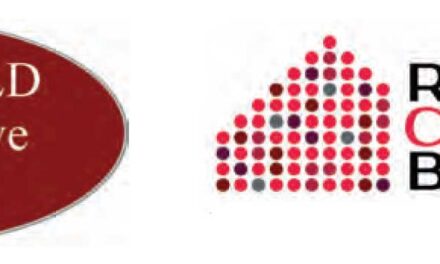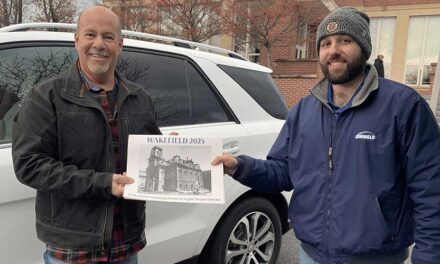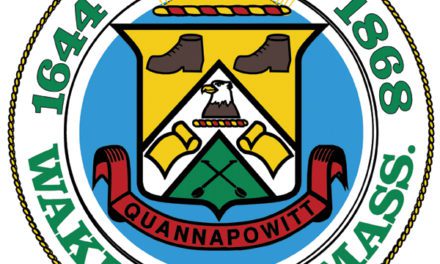NORTH READING — The responses to 14 frequently asked questions (FAQs) posed by the town regarding compliance requirements with the new MBTA Communities Act were answered by Town Counsel Jonathan D. Eichman, Esq., of KP Law, at the request of Town Administrator Michael Gilleberto.
Eichman also attended Monday night’s Select Board meeting to answer additional questions posed by the Select Board and Community Planning Commission (CPC).
Next Tuesday, the CPC will hold its required public hearing on the MBTA Communities Act as the sponsors of the warrant articles under consideration for adoption at the October 7 Town Meeting. The state has set a deadline of Dec. 31, 2024 for North Reading to comply with the law.
Additionally, the Select Board will hold its own public hearing on all the warrant articles in the October Town Meeting on Monday, September 30. The public is invited to attend and participate in both of these meetings, either in person or virtually, and also discuss the articles on Town Meeting floor.
RE: G.L. c.40A, §3A – MBTA Zoning (“MBTA Community”)
You have requested answers to questions concerning the Town’s designation as a “MBTA Community” and its responsibility as it pertains to compliance with the law. Your questions and my answers are set forth individually below. As referenced herein, “3A” or “Section 3A” refers to G.L. c. 40A, § 3A.
1. Is North Reading an MBTA Community?
Yes. The Zoning Act, G.L. c. 40A, § 1A, defines “MBTA Community” as: “a city or town that is: (i) one of the 51 cities and towns as defined in section 1 of chapter 161A; (ii) one of the 14 cities and towns as defined in said section 1 of said chapter 161A; (iii) other served communities as defined in said section 1 of said chapter 161A; or (iv) a municipality that has been added to the Massachusetts Bay Transportation Authority under section 6 of chapter 161A or in accordance with any special law relative to the area constituting the authority.”
Pursuant to G.L. c. 161A, § 1, North Reading is designated as one of the “other served communities.” A highlighted copy of the statute is attached hereto for your reference. Therefore, North Reading is an MBTA Community for the purposes of the Zoning Act, G.L. c. 40A, § 3A.
2. Does North Reading need to comply with the 3A/MBTA Communities zoning requirements for multifamily housing?
In my opinion the relevant statutory language makes compliance with those requirements mandatory. G.L. c. 40A, § 3A(a)(1), states in relevant part: “An MBTA community shall have a zoning ordinance or by-law that provides for at least 1 district of reasonable size in which multi-family housing is permitted as of right . . .” [emphasis added].
If an MBTA Community does not adopt the required zoning district, G.L. c. 40A, § 3A(b) further provides:
An MBTA community that fails to comply with this section shall not be eligible for funds from: (i) the Housing Choice Initiative as described by the governor in a message to the general court dated December 11, 2017; (ii) the Local Capital Projects Fund established in section 2EEEE of chapter 29; (iii) the MassWorks infrastructure program established in section 63 of chapter 23A, or (iv) the HousingWorks infrastructure program established in section 27 of chapter 23B.
In addition, the Executive Office of Housing and Livable Communities (“EOHLC”), which the Legislature has expressly charged with promulgating guidelines to determine compliance with the statutory requirements of G.L. c. 40A, § 3A, has indicated in Section 9 of the Compliance Guidelines it has issued (a copy of which is also attached hereto) that the following discretionary grant programs will take compliance with Section 3A into consideration when making grant award recommendations:
• Community Planning Grants, EOHLC;
• Massachusetts Downtown Initiative, EOED;
• Urban Agenda, EOED;
• Rural and Small Town Development Fund, EOED;
• Brownfields Redevelopment Fund, MassDevelopment;
• Site Readiness Program, MassDevelopment;
• Underutilized Properties Program, MassDevelopment;
• Collaborative Workspace Program, MassDevelopment;
•Real Estate Services Technical Assistance, MassDevelopment;
• Commonwealth Places Programs, MassDevelopment;
• Land Use Planning Grants, EOEEA;
• Local Acquisitions for Natural Diversity (LAND) Grants, EOEEA; and
• Municipal Vulnerability Preparedness (MVP) Planning and Project Grants, EOEEA.
Lastly, and as you may know, the Massachusetts Attorney General has filed suit against the Town of Milton in response to its noncompliance with Section 3A. The Attorney General has taken the position that compliance with the statute is mandatory, and that penalties in addition to those set forth in the statute may be imposed to compel compliance. We are awaiting the Court’s decision on that matter to determine if the State may compel compliance through Court order in addition to the funding disqualification expressly provided for in the statute.
3. What makes a community an MBTA Community, and was a vote required in order for the Town to achieve this status?
There is no local vote required in order for a Town to be designated as an MBTA Community. The Town is an MBTA Community by law, pursuant to the Legislature’s adoption, and former Governor Baker’s approval, of the “Housing Choice Act” on January 14, 2021, which has been codified in relevant part in G.L. c.40A, Section 3A. Please also see my response to Question #1 above.
4. Does the Town need to comply with the .5-mile distance requirement stated in 3A, since there is a section of the statute that says communities must comply with this, even though the guidelines subsequently issued by the state for the rollout of the program exempt towns such as North Reading from this requirement (we have no transit station within .5 miles of our borders)?
In my opinion, the Town is not required to comply with the 0.5-mile distance requirement stated in Section 3A because it has less than 100 acres of “developable station area” within its boundaries, as determined by EOHLC. Pursuant to Section 8(b) of the Compliance Guidelines:
When an MBTA community has less than 100 acres of developable station area within its boundaries, the MBTA community may locate the multi-family zoning district anywhere within its boundaries. To encourage transit-oriented multi-family housing consistent with the general intent of Section 3A, MBTA communities are encouraged to consider locating the multi-family zoning district in an area with reasonable access to a transit station based on existing street patterns, pedestrian connections, and bicycle lanes, or in an area that qualifies as an “eligible location” as defined in Chapter 40A—for example, near an existing downtown or village center, near a regional transit authority bus stop or line, or in a location with existing under-utilized facilities that can be redeveloped into new multi-family housing [emphasis added].
EOHLC has determined that North Reading has no “developable station area” within its boundaries. SeeAppendix1oftheComplianceGuidelines. Therefore,andinmyopinion, the Town is not required to comply with the 0.5-mile distance requirements stated in Section 3A.
5. 104 Lowell Road (Martins Landing) is an existing 55+ residential development proposed to be included within the MBTA zoning district. Can this property qualify as eligible land area under MBTA communities zoning?
Yes. Developed land may be included within the district, and, with some exceptions not relevant here (such as privately-owned land used for educational or institutional uses), may be counted as land that may be developed for multi-family use by right, regardless of the nature of the current use. For purposes of Section 3A compliance, the analysis is whether or not the new zoning bylaw would permit the development of as-of-right multi-family housing on the land within the district. As stated in the Compliance Guidelines, compliance requires only that an MBTA community show that its zoning “allows multi- family housing as of right and that a sufficient number of multi-family housing units could be added to or replace existing uses and structures over time—even though such additions or replacements may be unlikely to occur soon” [emphasis added].
6. Would placing the Martins Landing property within the MBTA communities zoning district eliminate or negate the 55+ requirement applicable to that development?
No. In my opinion, the inclusion of an existing 55+ residential development such as Martins Landing in an MBTA overlay district would not eliminate or negate the 55+ requirement applicable to those developments. MBTA zoning requires that multi-family housing be allowed by right without age restrictions in a zoning district of a certain size and capacity, but it does not otherwise govern what uses may be allowed or prohibited in the district. Thus, an MBTA zoning district that allowed multi-family housing by right without age restriction and had sufficient area and capacity to allow development of unrestricted multi-family housing in quantities meeting MBTA zoning requirements could continue to allow age-restricted housing by right or by special permit in the district provided that unrestricted multi-family housing is allowed by right throughout the district regardless of what other uses have or may be permitted.
Alternatively, if the Town chose, an MBTA district could prohibit age-restricted development, but because zoning changes do not apply to existing uses and structures, such a prohibition would not apply to existing age-restricted developments in the district. If the new MBTA Zoning Bylaw/overlay district prohibited 55+ residential use, the existing 55+ use in the district could continue as a lawful pre-existing nonconforming use.
7. 3A states communities not in compliance shall not be eligible for four grant programs. Other programs have been added since. Is this consistent with the law?
G.L. c.40A, §3A lists specific grant programs for which eligibility would be lost as a result of noncompliance. The EOHLC Guidelines, however, indicate that other grant programs will take 3A compliance into consideration. Those grant programs have not been added to the list in the statute for automatic disqualification. However, the State may impose reasonable requirements on disposition of State grant funds consistent with the purpose for which the funds may be used, and in my opinion such requirements could include compliance with 3A.
8. Can a zoning bylaw amendment to comply with 3A overrule or negate a condominium association regulation, such as number of bedrooms, affordability, or age restrictions? Specifically, could this be done at Martin’s Landing?
In my opinion a zoning bylaw amendment cannot as a matter of law overrule or negate a condominium association regulation. For further discussion of this issue please see my answer to Question No. 6, above.
9. Is the Attorney General seeking to have a third party appointed by a judge amend the Town of Milton’s zoning bylaws to comply with 3A?
The complaint filed by the Attorney General in the Milton case does not request that form of relief. It does, however, seek as alternative relief an order compelling the Town to enforce its zoning bylaws as if the Town was in compliance with 3A. How that would work is uncertain, at best. It could require someone to develop an ad hoc amendment to the Bylaws to carry out such an order.
10. Can wetlands be filled in in North Reading and then recreated/replicated in another community?
Wetlands replication must be in the same general area as the impacted wetland, and must satisfy several other requirements related to replacing the wetlands being lost. Ordinarily an adjacent or nearby location will best satisfy those requirements, but I am not aware of any specific requirement that replication take place wholly within one community.
11. Are aquifer protection districts not protected if re-zoned within the parameters of 3A?
Zoning amendments alter the Zoning Bylaws as stated in the amendment. There is nothing inherent in amendments to comply with 3A and there is nothing in the proposed amendment before Town Meeting that would eliminate aquifer protection districts.
12. Can a community that has complied with 3A be brought out of compliance after the fact if, for example, a parcel that was developable at the time of initial 3A compliance is encumbered with a conservation restriction?
In my opinion, applying the current guidance promulgated by EOHLC, it is possible that acts of private property owners, such as granting conservation restrictions, could render an MBTA zoning district non-compliant under the formulas for calculating capacity. However, current EOHLC guidelines provide that only actions of the Town could render a compliant district non-compliant. I expect that the Town would have an opportunity to adjust its zoning to comply without penalty once it became aware of the situation that it did not create.
13. Does a town have the authority to determine the quantum of vote to approve zoning bylaw amendments?
No. G.L. c.40A, §5 establishes the quantum of vote for different zoning bylaw amendments.
14. Is there a process by which property owners potentially impacted by a zoning bylaw amendment can petition to increase the quantum of vote for Town Meeting approval of zoning bylaw amendment?
They would need to petition Town Meeting to authorize the Select Board to seek special legislation to provide for a different quantum. In my opinion it is very unlikely that the Legislature would enact such legislation for a single municipality.




